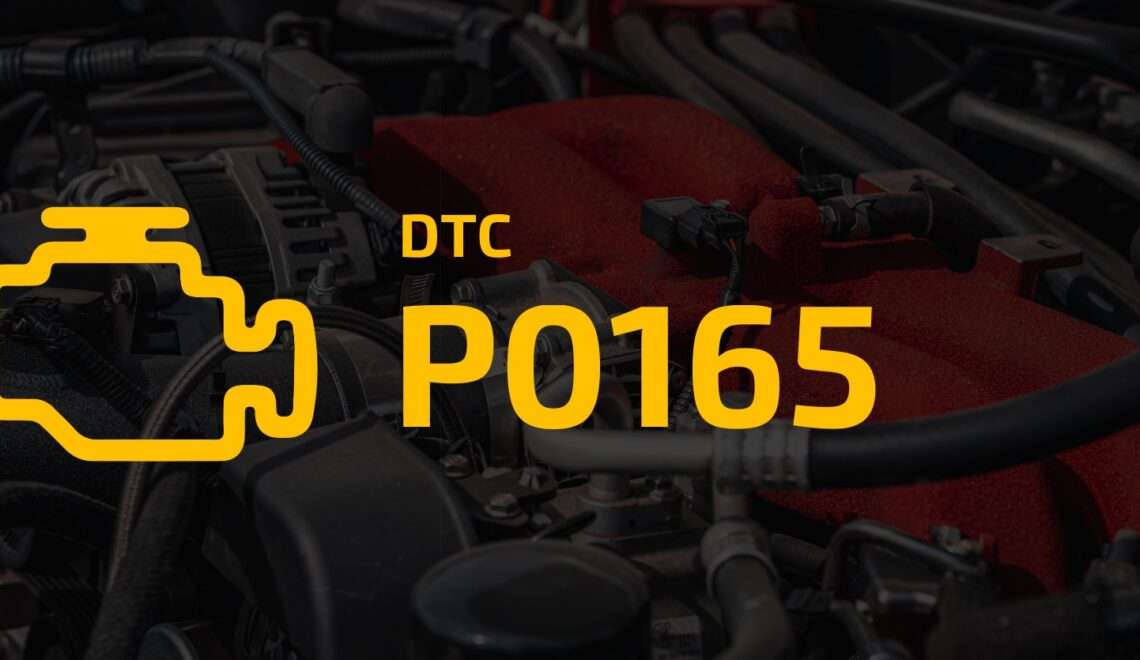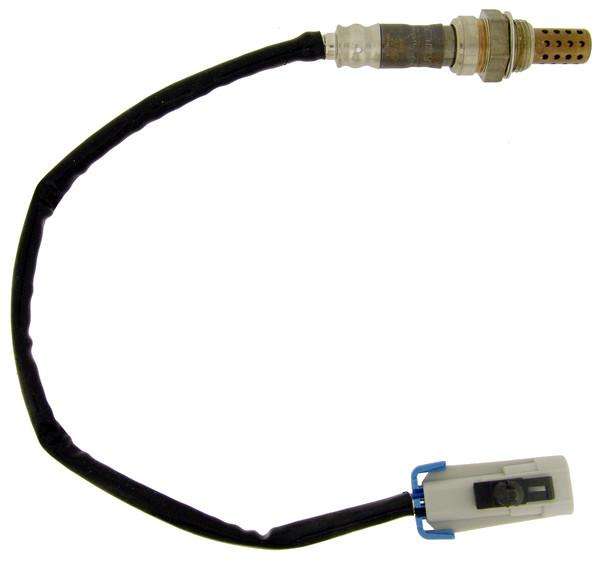
P0165 Oxygen sensor circuit slow response (sensor 3, bank 2)
Content
P0165 – OBD-II Trouble Code Technical Description
Trouble code P0165 indicates a slow response of the oxygen sensor circuit (sensor 3, bank 2).
What does the fault code mean P0165?
Trouble code P0165 indicates that the engine control module (PCM) is not receiving proper response from the oxygen sensor.
Trouble code P0165 indicates a slow response of the oxygen sensor circuit (sensor 3, bank 2).
The oxygen sensor detects the oxygen content in the vehicle's exhaust gases and sends a corresponding signal to the PCM in the form of a reference voltage. If the voltage drops below the manufacturer's specification due to higher resistance in the circuit, this fault code is stored in the PCM's memory.
The P0165 code may also appear if the voltage from the oxygen sensor remains the same for a long period of time, indicating that the sensor is responding slowly.

Possible reasons
Possible reasons that may cause DTC P0165 to appear:
- Oxygen sensor malfunction: The oxygen sensor may be damaged or worn, resulting in an incorrect or missing signal.
- Problems with wiring and connections: Wiring, connections or connectors may be damaged, broken or corroded, which may interfere with the signal from the oxygen sensor to the PCM.
- Malfunctioning PCM: The engine control module (PCM) itself may be faulty, causing it to not properly process signals from the oxygen sensor.
- Problems with the car's electrical system: Insufficient power or shorts in the vehicle's electrical system can cause the O2 sensor and PCM to malfunction.
- Incorrect installation or replacement of components: If the oxygen sensor was incorrectly installed or replaced, this may also cause this error to appear.
To accurately determine the cause, it is necessary to conduct a thorough diagnosis of the exhaust system and electrical system of the vehicle.
What are the symptoms of a fault code? P0165?
Symptoms for DTC P0165 may vary depending on the specific vehicle and other conditions, but some common symptoms include:
- Illuminates the Check Engine indicator: Typically, the main sign of an engine management system problem is the illumination of the Check Engine light on your dashboard.
- Loss of power and performance: Malfunctioning oxygen sensor and PCM malfunction can result in loss of engine power and overall vehicle performance.
- Unstable engine operation: The engine may run rough or become uneven when accelerating.
- Increased fuel consumption: Due to improper operation of the engine management system and the use of a suboptimal mixture of fuel and air, increased fuel consumption may occur.
- Unstable idle speed: The engine may be unstable at idle due to improper operation of the control system.
If you experience any of these symptoms, it is recommended that you visit an auto mechanic for diagnosis and troubleshooting.
How to diagnose a fault code P0165?
To diagnose DTC P0165 (oxygen sensor and related systems problems), follow these steps:
- Check the Check Engine Light: If your Check Engine Light is on, connect the vehicle to a diagnostic scan tool to obtain trouble code P0165 and any other codes that may be stored in the PCM memory.
- Visual inspection: Check the wiring and connections of the oxygen sensor and PCM for damage, corrosion or breaks.
- Resistance test: Use a multimeter to check the resistance at the oxygen sensor and PCM connections. Abnormal values may indicate problems with the wiring or oxygen sensor.
- Voltage test: Check the voltage at the oxygen sensor terminals with the engine running. It must be stable and meet the manufacturer's specifications.
- Oxygen sensor test: If everything else looks normal, then the problem may be with the oxygen sensor. To do this, test the oxygen sensor using a special tool or replace it with a known working one.
- PCM diagnostics: If all other checks do not indicate problems, the PCM may have a problem. This may require specialized tools and equipment to diagnose and repair the PCM.
If you do not have experience in diagnosing cars, it is better to contact a qualified auto mechanic or service center for diagnosis and repair.
Diagnostic errors
When diagnosing DTC P0165, the following errors may occur:
- Incorrect interpretation of error code: Sometimes mechanics may misinterpret an error code or focus on only one aspect of the problem without considering other possible causes.
- Erratic test results: Testing may produce unstable results due to poor connections, noise or other factors, which may lead to incorrect conclusions.
- Problems with the electrical system: If no obvious problems are detected with the oxygen sensor or PCM, there may be electrical system problems such as opens, corrosion, or shorts that may be missed during diagnosis.
- Inadequate testing: Not performing a complete diagnosis may result in missing important problems that may be related to other vehicle components that affect the performance of the oxygen sensor.
- Incorrect component replacement: Replacing the oxygen sensor or PCM without careful analysis first may result in repair costs without solving the actual problem.
To successfully diagnose and repair a P0165 code, it is important to carefully monitor all aspects of the process and rule out all possible causes of the problem before attempting component replacement or repair.
How serious is the fault code? P0165?
Trouble code P0165 indicates a problem with the oxygen sensor or related systems. Depending on the specific cause, the severity of this problem may vary. In general, a malfunctioning oxygen sensor can lead to the following problems:
- Increased emissions: A faulty oxygen sensor can result in less than optimal mixing of fuel and air, ultimately leading to increased emissions.
- Loss of power and poor fuel economy: Improper operation of the oxygen sensor can result in loss of engine power and poor fuel economy due to improper fuel/air mixture.
- Unstable engine operation: In some cases, a faulty oxygen sensor can cause the engine to run rough or even stall.
- Damage to catalyst: Prolonged operation with a faulty oxygen sensor may cause damage to the catalyst due to improper mixture operation.
Overall, although a P0165 code does not always indicate a serious problem, it still requires careful attention and repair. A malfunctioning oxygen sensor can lead to poor performance and environmental problems, so it is recommended to promptly diagnose and correct the problem.
What repair will help eliminate the code? P0165?
To resolve DTC P0165, you can take the following steps:
- Replacing the oxygen sensor: If the oxygen sensor is identified as the source of the problem, replacing it with a new, working unit may solve the problem.
- Checking wiring and connections: Perform a detailed check of the wiring and connections associated with the oxygen sensor and engine control module (PCM). Make sure there are no breaks, corrosion or burnt contacts. If necessary, repair or replace damaged wires.
- PCM replacement: If other problems have been ruled out but the problem still exists, the problem may be with the PCM. In this case, replacing or reprogramming the engine control unit may be necessary.
- Diagnostics of additional systems: Sometimes the problem may be related to other vehicle systems that affect the operation of the oxygen sensor. For example, problems with the intake system or ignition system can lead to oxygen sensor errors. Carry out additional diagnostics and repairs to relevant systems as necessary.
- Clearing the error code: After completing the repair, be sure to clear the error code from the PCM memory using a diagnostic scan tool. This will allow you to check whether the problem was successfully resolved and monitor whether it occurs again.
If trouble code P0165 occurs, it is recommended that you contact a qualified auto mechanic or service center for diagnosis and repair, especially if you are not confident in your auto repair skills.
P0165 – Brand-specific information
Brand-specific information about the P0165 trouble code may vary depending on the vehicle manufacturer. Below are the decodings for some brands:
- Toyota / Lexus: Insufficient voltage of oxygen sensor No. 3 on bank No. 2.
- Honda/Acura: Insufficient feedback voltage of oxygen sensor No. 2 on bank No. 2.
- Nissan/Infiniti: Low voltage in the oxygen sensor circuit No. 3 on bank No. 2.
- Ford: Insufficient voltage of oxygen sensor No. 3 on bank No. 2.
- Chevrolet / GMC: Insufficient voltage of oxygen sensor No. 3 on bank No. 2.
- BMW: Insufficient signal voltage from oxygen sensor No. 3 on bank No. 2.
- Mercedes-Benz: Insufficient signal voltage from oxygen sensor No. 3 on bank No. 2.
- Audi/Volkswagen: Insufficient signal voltage from oxygen sensor No. 3 on bank No. 2.
- Subaru: Low signal voltage of oxygen sensor No. 3 on bank No. 2.
- Hyundai/Kia: Insufficient voltage of oxygen sensor No. 3 on bank No. 2.
- Mazda: Low signal voltage of oxygen sensor No. 3 on bank No. 2.
- Volvo: Low voltage of oxygen sensor No. 3 on bank No. 2.
- Jeep / Chrysler / Dodge: Insufficient voltage of oxygen sensor No. 3 on bank No. 2.
It is important to consider that decryptions may vary depending on the year of manufacture, model and market of the vehicle. It is recommended that you consult your service manual or a qualified mechanic for accurate information.